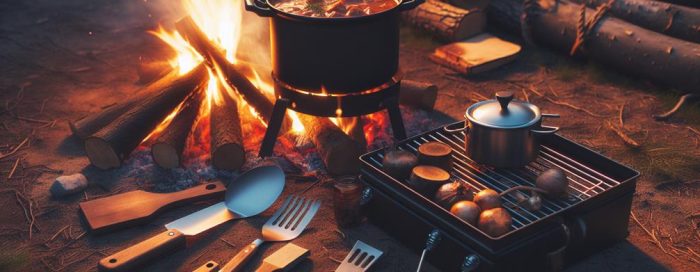You're standing in the midst of nature, the crackling of the campfire and the scent of the outdoors embracing you. As a beginner in bush cooking, you might feel a bit overwhelmed by the idea of preparing meals in the wild. However, fear not, for there are simple and effective techniques that can transform your outdoor cooking experience. Whether it's mastering the art of slow-cooking over coals or creating delicious one-pot meals, these techniques will not only help you whip up tasty dishes but also ignite your passion for outdoor culinary adventures.
Campfire Cooking Equipment
When venturing into bush cooking, having the right campfire cooking equipment is essential for a successful outdoor culinary experience. A cast iron skillet and Dutch oven are indispensable tools for creating delicious meals over a campfire. The cast iron skillet is perfect for cooking up breakfast classics like bacon and eggs, while the Dutch oven excels at making hearty stews and flavorful roasts. These sturdy pieces of equipment can withstand the direct heat of the fire and distribute heat evenly for consistent cooking. Their versatility allows you to prepare a wide range of dishes, making them essential for any outdoor cooking adventure. With the proper tools like these, you can elevate your campfire cooking game and create memorable meals that will have you feeling like a seasoned outdoor chef.
Essential Fire-Starting Techniques
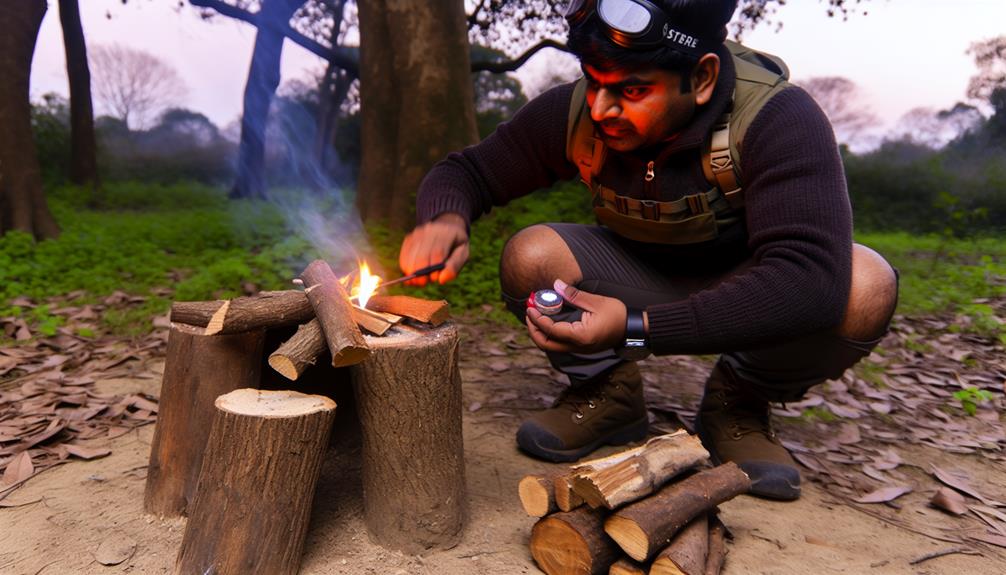
When it comes to starting a fire in the bush, having the right tools and knowing how to select the right firewood are essential. Knowing the proper fire-starting techniques can make a big difference in your cooking experience. Let's explore the important points of fire-starting tools and firewood selection to ensure a successful campfire cooking experience.
Fire-Starting Tools
To ensure successful campfire cooking, mastering essential fire-starting techniques is crucial. When it comes to fire-starting tools, it's important to have the right equipment and knowledge. Basic tools like matches, lighters, and fire starters are essential for starting a campfire. Different fire-starting techniques, such as using kindling or fire starter sticks, can be learned and practiced. Safety should always be a priority when using fire-starting tools. Remember to keep flammable materials away from the fire, have water nearby for emergencies, and follow any specific guidelines for the area you're camping in. By understanding fire starting techniques and prioritizing fire starting safety, you can ensure a successful and enjoyable cooking experience in the great outdoors.
Firewood Selection
Selecting the right firewood is essential for mastering fire-starting techniques and ensuring a successful campfire cooking experience. When choosing firewood, opt for dry, seasoned hardwoods such as oak, maple, or hickory for a clean and efficient burn. Avoid using softwoods like pine or cedar, as they produce excess soot and sap, leading to a smoky and less effective fire. It's also important to select a variety of firewood sizes, from kindling for easy ignition to larger logs for sustained heat and coals. Understanding different firewood types and their burning characteristics is essential for efficient campfire cooking. Additionally, consider firewood storage to keep it dry and ready for use, and explore firewood types suitable for smoking to enhance the flavor of your campfire meals.
Simple Meal Planning Tips
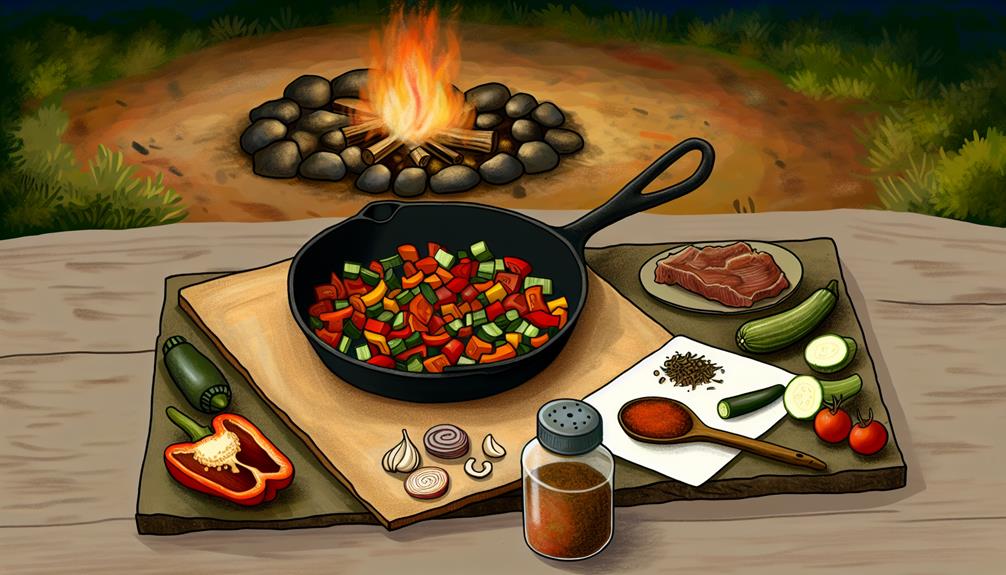
When planning your meals, consider menu selection, ingredient preparation, and cooking time management. Start by choosing a variety of dishes for the week, then prepare versatile ingredients that can be used in multiple recipes, and finally, manage your time effectively to ensure everything gets cooked on time. Keeping these points in mind will help you streamline your meal planning process and make cooking in the bush a lot more enjoyable.
Menu Selection
Consider the number of people and their preferences as you plan your meals for a smooth and enjoyable campfire cooking experience. Here are some simple meal planning tips to help you select the perfect menu:
- Opt for one pot meals to minimize cleanup and make cooking easier.
- Include vegetarian options to cater to different dietary preferences within your group.
- Choose recipes with minimal ingredients to simplify the cooking process over a campfire.
- Plan meals in advance to ensure you have all the necessary ingredients and equipment for a hassle-free cooking experience.
Ingredient Preparation
As you plan your meals for a smooth campfire cooking experience, streamline your ingredient preparation by considering the cooking methods you'll be using and preparing your ingredients accordingly. Embrace time-saving hacks by prepping ingredients in advance. Chop vegetables, marinate meats, and portion out spices before your camping trip to save time and effort at the campsite. Additionally, consider meal prepping tips such as utilizing versatile ingredients that can be used in multiple dishes, reducing the need to pack and prepare numerous items. Keep it simple by choosing recipes with minimal ingredients and easy preparation techniques, allowing you to focus on enjoying the outdoor experience rather than spending excessive time on meal preparation. By planning and prepping your ingredients thoughtfully, you can simplify the cooking process and make the most of your time in the great outdoors.
Cooking Time Management
To effectively manage your cooking time while camping, prioritize meal planning in advance to streamline your cooking process and enjoy more time outdoors. Here are some meal preparation techniques to help you manage your cooking time efficiently:
- Prep ingredients in advance: Chop vegetables, marinate meat, and organize ingredients ahead of time for quicker cooking.
- Utilize one-pot meals: Opt for recipes that allow you to cook everything in a single pot or pan to save time and effort.
- Use a timer: Set timers for each cooking task to ensure that nothing is overcooked or undercooked.
- Clean as you go: Tidy up the kitchen and wash dishes as you cook to avoid a big mess at the end.
Basic Bush Cooking Methods
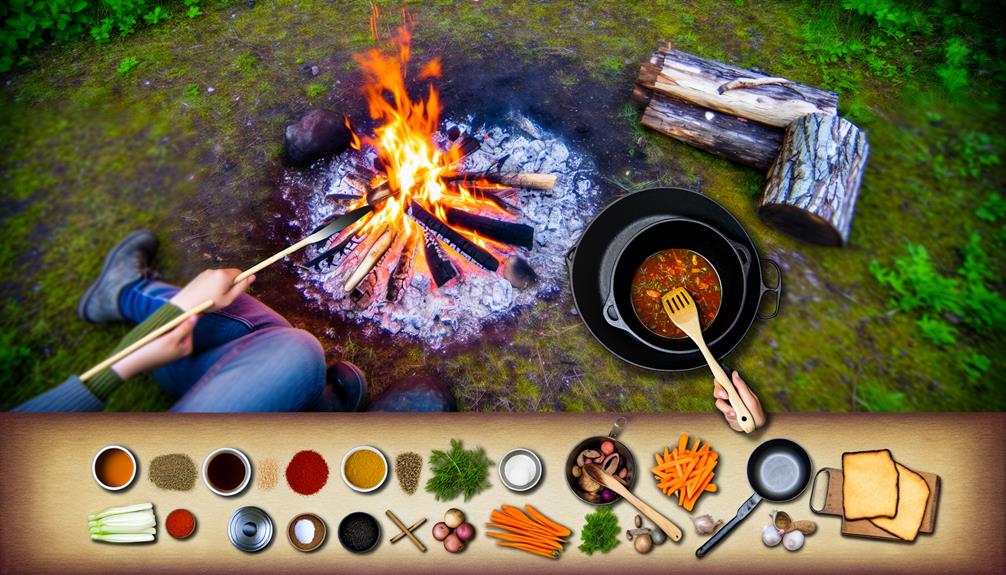
When cooking over a campfire, mastering the art of using coals to slowly cook your meals can result in delicious flavors and is a skill that can be applied to a variety of recipes. One-pot meals simplify cooking over a campfire and build confidence in outdoor cooking. Toasted sandwiches and pie iron cooking are beginner-friendly and open up possibilities for other recipes. Campfire desserts like chocolate chip s'mores and chocolate bananas are easy and satisfying treats. Cooking fish over a campfire, like campfire fried salmon, offers a delicious and easy option for outdoor cooking.
| Campfire Recipe Ideas | Outdoor Cooking Techniques |
|---|---|
| One-Pot Meals | Slow Cooking Over Coals |
| Toasted Sandwiches | Pie Iron Cooking |
| Campfire Desserts | Cooking Fish |
Easy Campfire Recipes
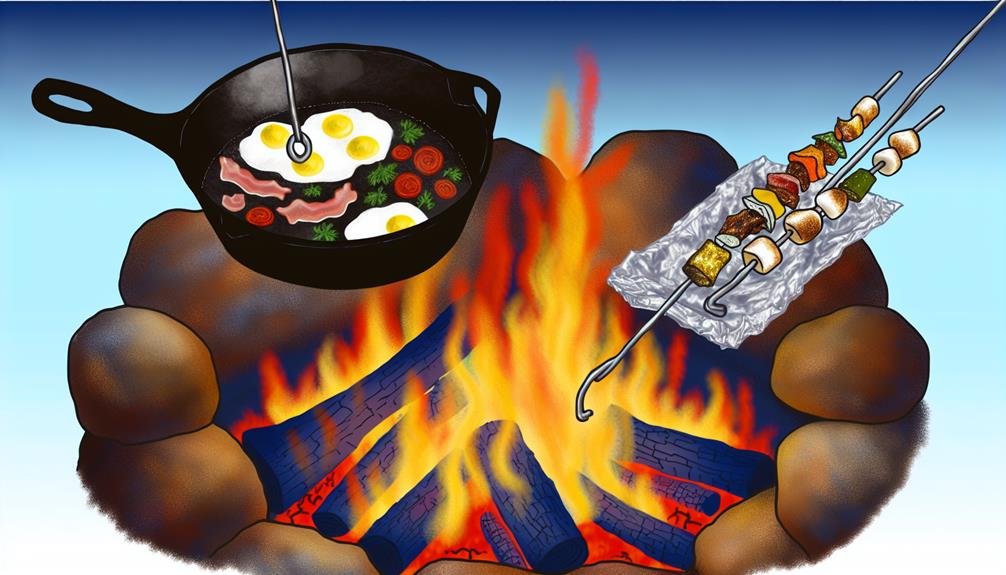
Mastering the basic bush cooking methods has opened up the door to easy campfire recipes that will further enhance your outdoor cooking experience. When it comes to campfire cooking, these tips and cooking utensils will make your meals a breeze:
- Beef in Biscuits: Wrap beef sausages in biscuit dough and cook them slowly over coals for a golden brown result.
- Stuffed Baked Apples: Enjoy a simple campfire dessert by stuffing apples with dried fruit, wrapping them in foil, and baking them slowly in the coals.
- One-Pot Meals: Try a mock risotto cooked on the campfire using normal rice, canned soup, mushrooms, and chicken for a flavorful and easy one-pot meal.
- Toasted Sandwiches: Cook a ham and cheese toastie in a pie iron over the campfire, perfect for beginners and customizable with different fillings.
These easy campfire recipes will surely make you feel like a seasoned outdoor chef in no time.
Safety Tips for Cooking Outdoors
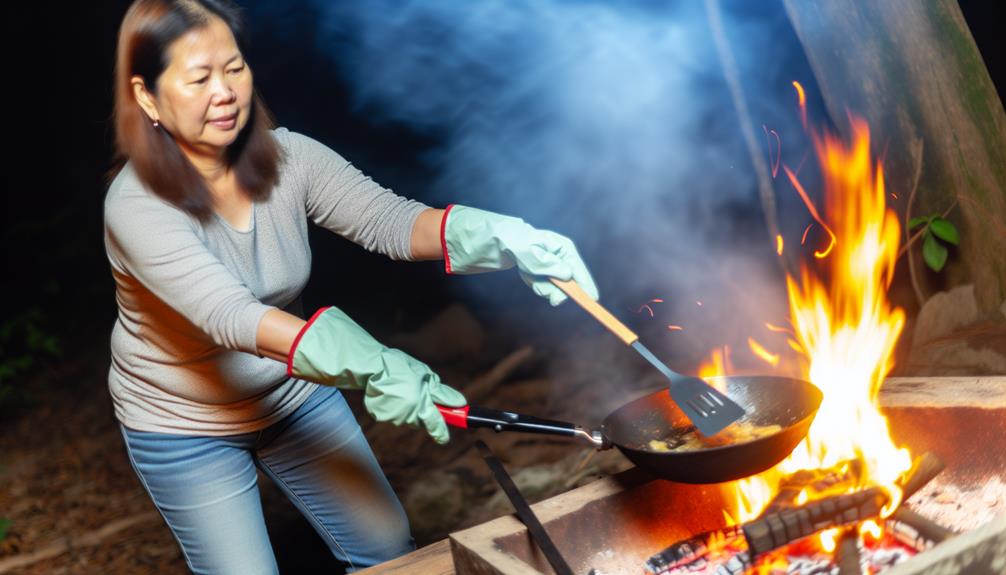
Ensure that a fire extinguisher or a bucket of water is readily accessible for emergencies when cooking outdoors. Prioritize fire safety by setting up your cooking area away from flammable materials like dry grass or overhanging branches. Never leave a fire unattended and always fully extinguish it after use. Use long-handled utensils to prevent burns and keep a first aid kit nearby. Be mindful of wind conditions and avoid using flammable liquids to start or boost a fire. Taking these outdoor cooking precautions will help ensure a safe and enjoyable experience for you and your fellow outdoor cooking enthusiasts. By being cautious and prepared, you can focus on creating delicious meals in the great outdoors without worrying about potential safety hazards.

